Safety & Gender Based Violence in the UK
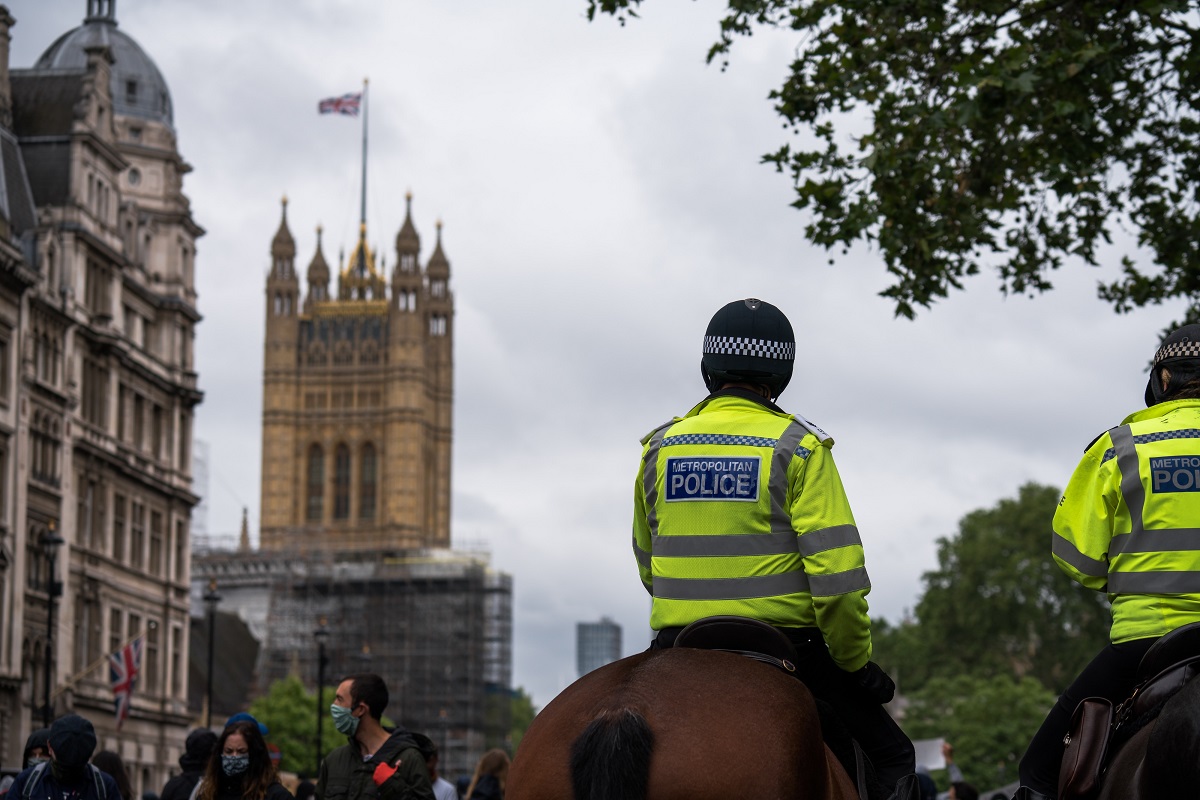
Trust in the police service
A quarter of UK adults do not trust the police Service to keep them safe.
A quarter (25%) of UK adults distrust the police service to keep them safe with one in ten (11%) saying they distrust the service a lot. Just 16% of UK adults stated they trust the police a lot to keep them safe and a fifth (23%) had no strong feelings either way. Women’s trust in the service is slightly less than their male counterparts (46% and 49%). Those aged 35-54 trust the service the least with just over two fifths (44%) stating they trust the police to keep them safe compared to just under half of 18-34s and over 55s (both 49%). Wales have the most trust with three fifths (59%) and Northern Ireland have the least trust with two fifths (40%).
When asked about trustworthy professions three fifths (60%) said doctors followed by 55% saying nurses. Other trustworthy professions include paramedic (57%), firefighter (53%), teacher (42%) and dentist (40%). It is interesting that the majority of the trustworthy professions include those in public services however just 28% would describe a police officer as trustworthy. Unsurprisingly the least trustworthy professions were sales person and politician (both 4%).
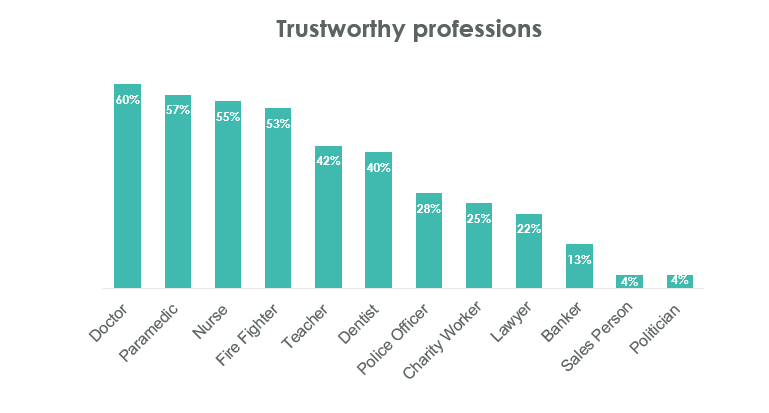
Police officer was rated trustworthy by a third (32%) of over 55s reducing to just over a fifth (23%) of 18-34s indicating the younger generation trusts the profession less. Again we see the highest number amongst Welsh respondents (43%) however it is Londoners who ranked police officers lowest (18%).
Feeling safe
A fifth of UK adults have felt unsafe on the street in the last 12 months
The most common place where UK adults have felt unsafe is on the street with a fifth (19%) saying they have felt unsafe there in the last year. For 17%, feeling unsafe at night has occurred in the last year with 35-54s feeling unsafe at night the most (22%).
One in ten (11%) UK adults have felt unsafe on public transport, this is highest amongst Londoners with a fifth (19%) having felt unsafe in the last year. Again, one in ten (11%) have felt unsafe in a park or outdoor space in the last year and this is higher for Londoners (16%).
Over a quarter (26%) of Londoners have felt unsafe either on the street or at night in the last year, from the graph below we can see those in London feel significantly less safe compared to other parts of the UK.
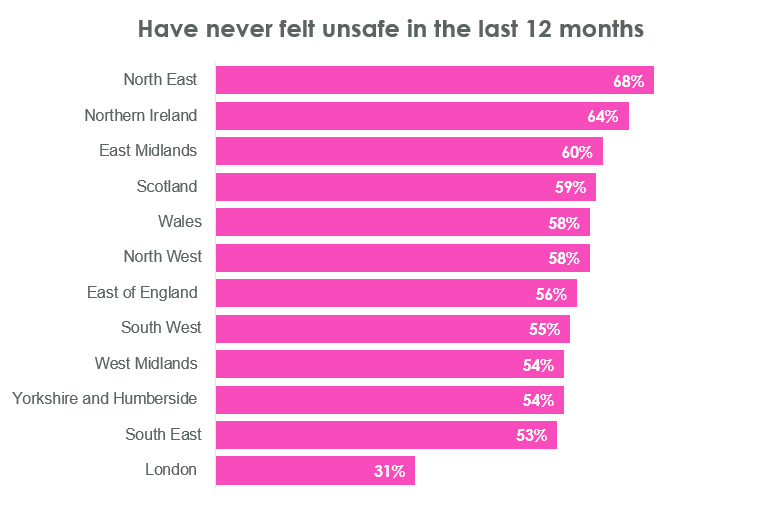
Whilst Londoners are feeling most unsafe, it also appears that the younger generation are feeling the least safe with six in ten (61%) having felt unsafe in last year compared to just a quarter (24%) of over 55s.
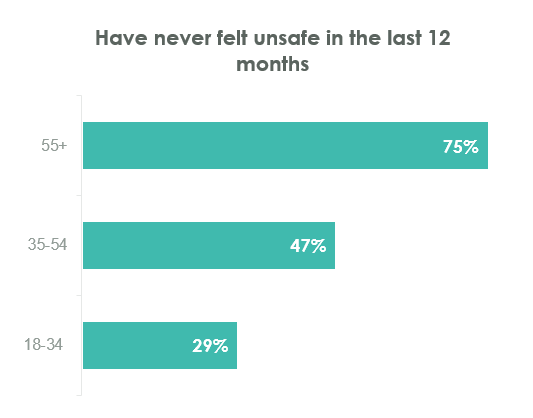
From the chart we can see the increase in percentage of those that have never felt unsafe in a place or situation in the last year goes up per age break being largest for the older generation.
1 in 10 UK women have felt unsafe in a bar or nightclub in the last year
Unsurprisingly across the places and situations that UK adults have felt unsafe in across the last 12 months, women have felt more unsafe in those places and situations than men. A quarter (23%) of women feel unsafe on the street compared to just 14% of men. A fifth (21%) of women have felt unsafe at night in the last year compared to 14% of men.
In a park or outdoor space, women are twice as likely to feel unsafe (14% vs 7%).
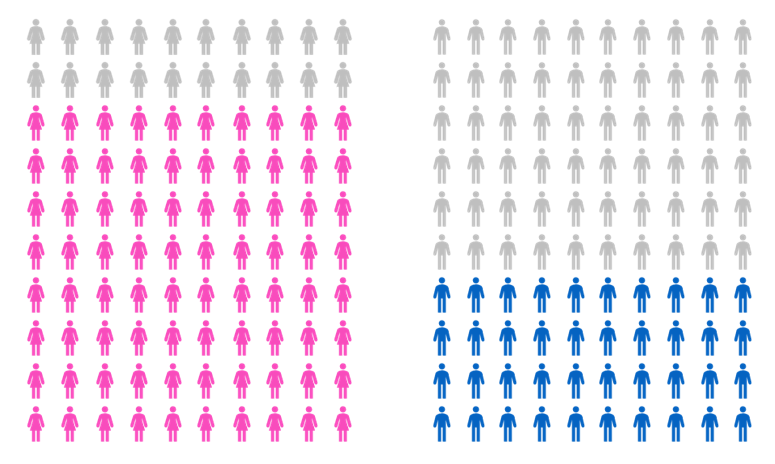
A quarter of UK adults don’t go out at certain times to feel safer
Almost two fifths (37%) of UK adults avoid certain areas to feel safer and a third (34%) walk in well lit areas. A quarter (26%) also avoid going out at certain times. Those in the East of England and the East Midlands are most likely to avoid certain areas (both 41%). East Midlanders are also more likely to walk in well lit areas (40%) and not go out at certain times (36%).
A quarter of UK women walk with keys in their hand for protection
When looking at the differences between what men and women do to feel safer, the disparity continues with significant increases in the number of women using different methods to feel safe.
Over a third (35%) of women avoid going out at certain times compared to a fifth (22%) of men. More than double the amount of men are also walking in well lit areas (45% vs 22%) and again, over double the amount of men don’t go out at certain times to feel safer (35% vs 17%).
A quarter (24%) of women have walked with keys in their hand to feel safer compared to just 10% of men and a fifth (21%) of women don’t listen to music or wear headphones compared to 11% of men.
Other methods used more by women to feel safer include having headphones in with no music playing (8%) and carry an alarm (8%). Almost two fifths (37%) of men don’t do anything to feel safer compared to just 18% of women.
One in five UK women speak to someone on the phone to feel safer
One in five (22%) women have spoken to someone on the phone to feel safer compared to just 7% of men. The significant increases continue across different ways to feel safe.
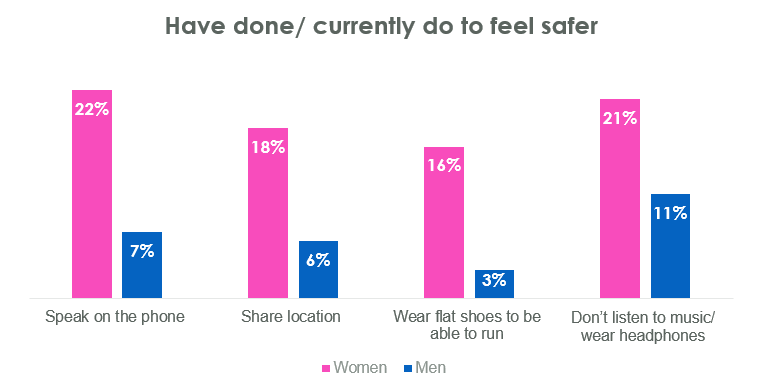
Gender based violence
Half of UK adults believe the police have a responsibility to contribute to reducing gender-based violence.
UK adults believe the police have the most responsibility with over half (51%) saying they have a responsibility to contribute to reducing gender-based violence. Over 55s hold this view more so than younger generations with three fifths (58%) saying the police have a responsibility. Almost half (48%) said the Government have the responsibility followed by two fifths (42%) saying men. Both men and women hold the view that men have a responsibility to contribute to the reduction of gender-based violence (41% and 43%).
Almost two fifths (37%) said parents and schools have a responsibility to reduce followed by over a quarter (27%) saying employers. The same amount (27%) said myself followed by 26% saying women. A fifth (22%) said businesses have a responsibility and 19% said charities.
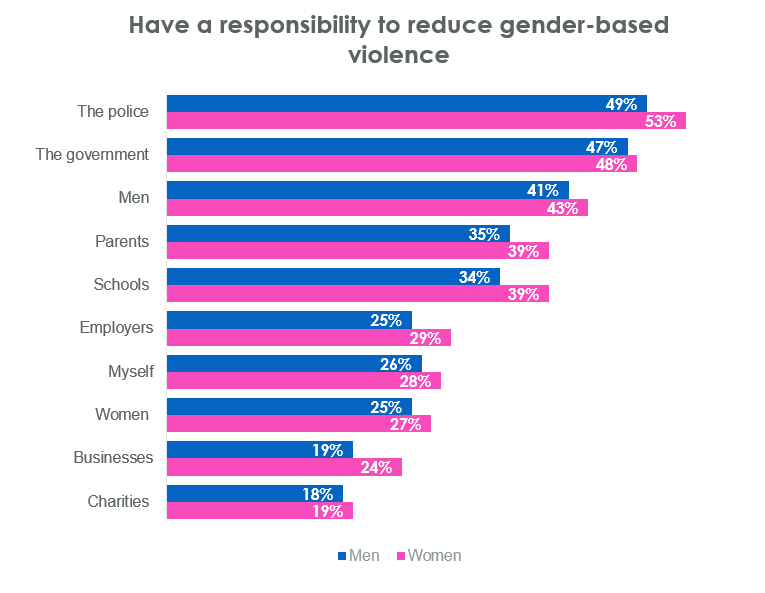
When asked about the main reasons behind gender-based violence, the main themes varied with a focus on more environmental aspects or personal circumstances such as a lack of education and suggestion of bad parenting or a difficult upbringing. Most responses alluded to the more social and wider cultural pressures such as internalised misogyny and toxic masculinity. Others said ignorance is a main factor as well as power and control being a push factor.
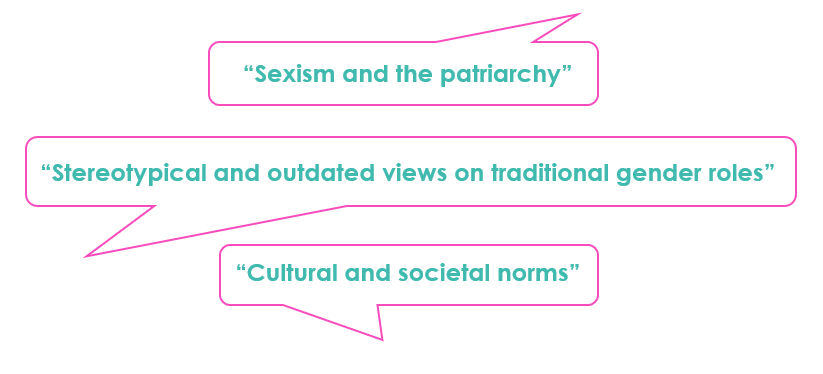
Half say education and awareness is the most effective solution for reducing gender-based violence
Over half (51%) have said that to reduce gender-based violence we need to begin education and awareness from an early age and ensure that it promotes gender equality and challenges gender norms. Almost two fifths (36%) said the most effective solution would be to address root causes such as promoting gender equality and positive masculinity as well as challenging gender norms. A third (32%) believe that an improvement on government policy would be the most effective solution, this would include strengthening and improving policies that protect against gender-based violence. One in ten (12%) said increasing funding for support services as well as providing accessible and well-resourced support.
The younger generation place more importance on both improvement on government policy (37%) and increased funding for support services (20%) whereas over 55s were more likely to say the solutions lies in education and awareness. The over 55s were also least sure about effective solutions to reduce gender-based violence with 22% selecting don’t know compared to just half the amount of 18-34 year olds (11%).
Written by Laura Foulkes, Senior Research Executive




